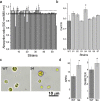Astaxanthin and eicosapentaenoic acid production by S4, a new mutant strain of Nannochloropsis gaditana
- PMID: 35710482
- PMCID: PMC9204945
- DOI: 10.1186/s12934-022-01847-9
Astaxanthin and eicosapentaenoic acid production by S4, a new mutant strain of Nannochloropsis gaditana
Abstract
Background: Astaxanthin is a ketocarotenoid with high antioxidant power used in different fields as healthcare, food/feed supplementation and as pigmenting agent in aquaculture. Primary producers of astaxanthin are some species of microalgae, unicellular photosynthetic organisms, as Haematococcus lacustris. Astaxanthin production by cultivation of Haematococcus lacustris is costly due to low biomass productivity, high risk of contamination and the requirement of downstream extraction processes, causing an extremely high price on the market. Some microalgae species are also primary producers of omega-3 fatty acids, essential nutrients for humans, being related to cardiovascular wellness, and required for visual and cognitive development. One of the main well-known producers of omega-3 fatty eicosapentaenoic acid (EPA) is the marine microalga Nannochloropsis gaditana (named also Microchloropsis gaditana): this species has been already approved by the Food and Drug Administration (FDA) for human consumption and it is characterized by a fast grow phenotype.
Results: Here we obtained by chemical mutagenesis a Nannochloropsis gaditana mutant strain, called S4, characterized by increased carotenoid to chlorophyll ratio. S4 strain showed improved photosynthetic activity, increased lipid productivity and increased ketocarotenoids accumulation, producing not only canthaxanthin but also astaxanthin, usually found only in traces in the WT strain. Ketocarotenoids produced in S4 strain were extractible in different organic solvents, with the highest efficiency observed upon microwaves pre-treatment followed by methanol extraction. By cultivation of S4 strain at different irradiances it was possible to produce up to 1.3 and 5.2 mgL-1 day-1 of ketocarotenoids and EPA respectively, in a single cultivation phase, even in absence of stressing conditions. Genome sequencing of S4 strain allowed to identify 199 single nucleotide polymorphisms (SNP): among the mutated genes, mutations in a carotenoid oxygenase gene and in a glutamate synthase gene could explain the different carotenoids content and the lower chlorophylls content, respectively.
Conclusions: By chemical mutagenesis and selection of strain with increased carotenoids to chlorophyll ratio it was possible to isolate a new Nannochloropsis gaditana strain, called S4 strain, characterized by increased lipids and ketocarotenoids accumulation. S4 strain can thus be considered as novel platform for ketocarotenoids and EPA production for different industrial applications.
Keywords: Astaxanthin; Carotenoids; Eicosapentaenoic acid; Microalgae; Omega-3 fatty acids.
© 2022. The Author(s).
Conflict of interest statement
Authors declare competing financial interest: a patent application having as main subject the results herein described has been submitted by the University of Verona (application no. 812020000210221, #PCT/IB2021/059969) having MB, MC, SC and SP among inventors.
Figures






References
-
- Boussiba S, Vonshak A, Cohen Z, Avissar Y, Richmond A. Lipid and biomass production by the halotolerant microalga nannochloropsis-salina. Biomass. 1987;12:37–47. doi: 10.1016/0144-4565(87)90006-0. - DOI
-
- Lluis L, Taltavull N, Munoz-Cortes M, Sanchez-Martos V, Romeu M, Giralt M, Molinar-Toribio E, Torres J, Perez-Jimenez J, Pazos M, et al. Protective effect of the omega-3 polyunsaturated fatty acids: Eicosapentaenoic acid/Docosahexaenoic acid 1:1 ratio on cardiovascular disease risk markers in rats. Lipids Health Dis. 2013 doi: 10.1186/1476-511X-12-140. - DOI - PMC - PubMed
MeSH terms
Substances
Grants and funding
LinkOut - more resources
Full Text Sources
Research Materials

